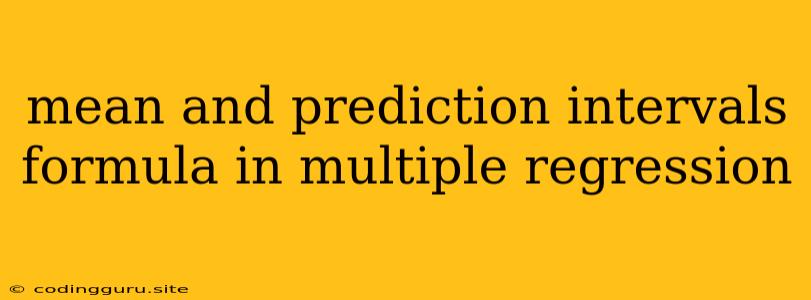Understanding Mean and Prediction Intervals in Multiple Regression
Multiple regression is a powerful statistical technique used to predict a dependent variable (Y) based on multiple independent variables (X1, X2, ..., Xp). While the regression model provides a best-fit line for the relationship between variables, it's crucial to understand the uncertainty associated with this prediction. This is where mean and prediction intervals come into play.
What are Mean and Prediction Intervals?
- Mean Interval: The mean interval, also known as the confidence interval, estimates the range within which the average value of Y is likely to fall for a given set of X values. It reflects the uncertainty in the estimated regression line itself.
- Prediction Interval: The prediction interval estimates the range within which an individual observation of Y is likely to fall for a given set of X values. It accounts for the uncertainty in the regression line and the inherent variability in the data.
How are Mean and Prediction Intervals Calculated?
The formulas for mean and prediction intervals in multiple regression are based on the following components:
- Regression Coefficients (b0, b1, ..., bp): These coefficients represent the estimated relationship between each independent variable and the dependent variable.
- Standard Error of the Estimate (SEE): This measures the average distance between the observed Y values and the predicted Y values from the regression line.
- t-statistic: This is a statistical measure used to assess the significance of the regression coefficients and for constructing confidence intervals.
- Degrees of Freedom (df): This refers to the number of independent observations available for estimating the regression parameters.
Formulas:
Mean Interval:
Ŷ ± t(df, α/2) * SEE * √(1/n + (X - X̄)ᵀ(XᵀX)⁻¹(X - X̄))
Prediction Interval:
Ŷ ± t(df, α/2) * SEE * √(1 + 1/n + (X - X̄)ᵀ(XᵀX)⁻¹(X - X̄))
Where:
- Ŷ is the predicted value of Y
- t(df, α/2) is the t-statistic for a given confidence level (α) and degrees of freedom (df)
- SEE is the standard error of the estimate
- n is the sample size
- X is the vector of independent variables for the specific prediction
- X̄ is the vector of means for the independent variables
- (XᵀX)⁻¹ is the inverse of the matrix obtained by multiplying the transpose of the X matrix by itself
Interpreting the Intervals:
- Mean Interval: A narrower mean interval indicates higher confidence in the estimated regression line. A wider interval suggests greater uncertainty in the prediction.
- Prediction Interval: A prediction interval is always wider than a mean interval for the same set of X values. This is because it accounts for both the uncertainty in the regression line and the inherent variability in the data.
Example:
Let's say you have a multiple regression model predicting house prices based on square footage and number of bedrooms. Using the above formulas, you can calculate the mean and prediction intervals for a specific house with 2,000 square feet and 3 bedrooms.
- The mean interval would estimate the average price range for all houses with 2,000 square feet and 3 bedrooms.
- The prediction interval would estimate the price range for a single house with 2,000 square feet and 3 bedrooms.
Tips for Using Mean and Prediction Intervals:
- Choose an appropriate confidence level (α) based on the desired level of confidence. Common confidence levels are 95% and 99%.
- Understand the limitations of the regression model. The intervals are based on assumptions about the data and the model's fit.
- Consider using other tools, such as residual plots, to assess the model's performance and potential violations of assumptions.
Conclusion:
Mean and prediction intervals provide valuable information about the uncertainty associated with predictions made using multiple regression models. By understanding the formulas and their interpretation, you can effectively assess the reliability of your predictions and make more informed decisions based on the results. Remember to use these intervals responsibly and consider the limitations of the model.
